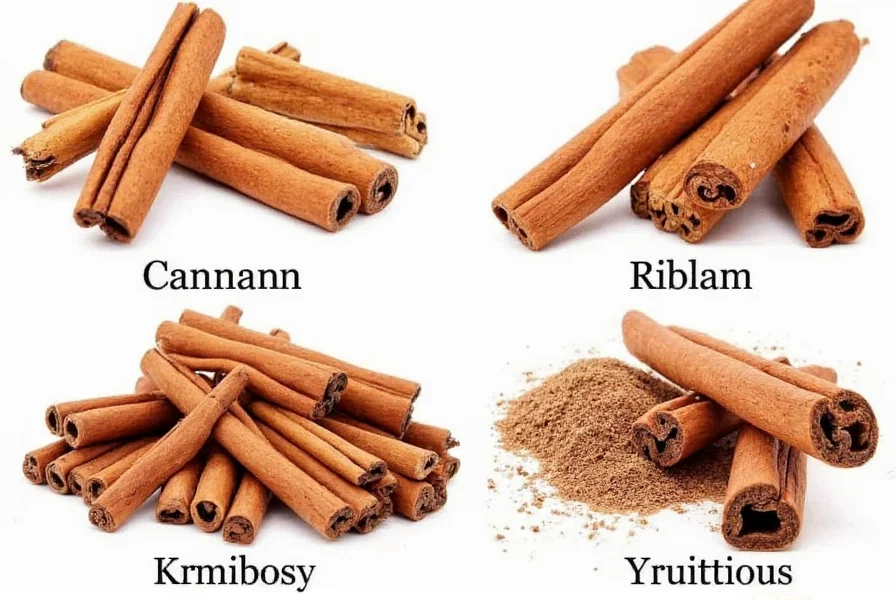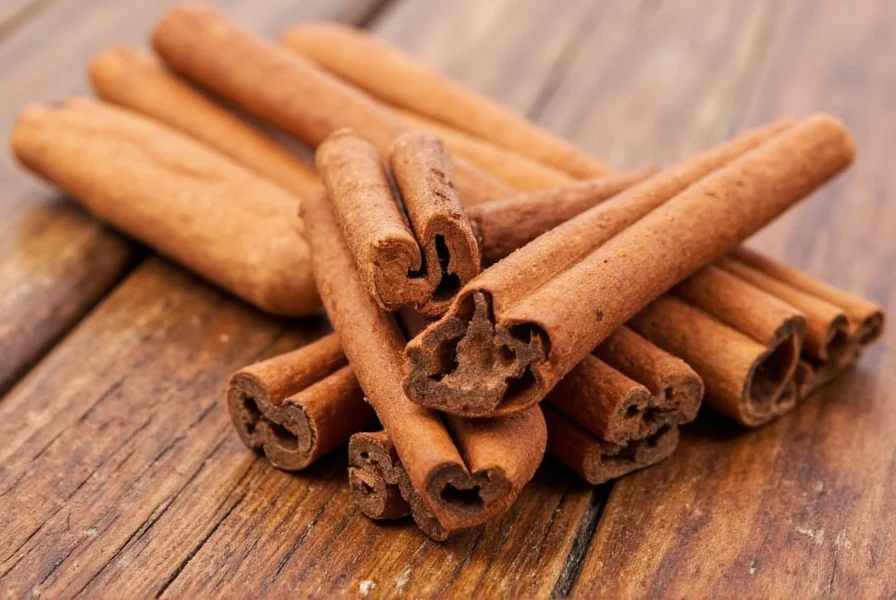Understanding the distinct varieties of cinnamon is essential for both culinary excellence and health awareness. While many consumers treat cinnamon as a single spice, significant differences exist between types that affect flavor intensity, safety profiles, and appropriate uses in cooking and baking. This comprehensive guide details the characteristics, benefits, and applications of each major cinnamon variety to help you make informed choices.
Major Cinnamon Varieties Explained
Cinnamon comes from the inner bark of trees in the Cinnamomum genus, but not all cinnamon is created equal. The differences between types stem from botanical variety, growing conditions, harvesting methods, and processing techniques. These variations create distinct flavor profiles, chemical compositions, and culinary properties that matter to both home cooks and professional chefs.
Ceylon Cinnamon (Cinnamomum verum)
Often called "true cinnamon," Ceylon cinnamon originates from Sri Lanka and southern India. This variety features multiple thin, delicate layers that form a tight, hollow tube. When compared to other types, Ceylon has a lighter color, more complex flavor profile with citrus notes, and significantly lower coumarin content.
Ceylon cinnamon contains only trace amounts of coumarin (approximately 0.017g per kg), making it the preferred choice for regular consumption, especially for children, pregnant women, or those with liver concerns. Its delicate flavor works exceptionally well in desserts, custards, and dishes where a subtle cinnamon presence is desired.

Cassia Cinnamon (Cinnamomum cassia)
Commonly labeled simply as "cinnamon" in supermarkets across North America, Cassia cinnamon comes primarily from China. This variety features a single, thick, hard bark layer that doesn't form a complete tube. Cassia has a stronger, more pungent flavor with higher oil content and significantly more coumarin (approximately 2.1-4.4g per kg).
Due to its robust flavor and lower cost, Cassia dominates the commercial market, accounting for roughly 90% of cinnamon sold in the United States. Its intense flavor makes it ideal for spice-heavy applications like cinnamon rolls, apple pie, and other baked goods where a pronounced cinnamon presence is desired.
Saigon Cinnamon (Cinnamomum loureiroi)
Hailing from Vietnam, Saigon cinnamon represents a particularly potent variety of Cassia. It contains the highest concentration of cinnamaldehyde (up to 25%) among all cinnamon types, giving it an exceptionally strong, sweet aroma and intense flavor. Saigon cinnamon also has very high coumarin content, even exceeding standard Cassia.
Chefs often use Saigon cinnamon when creating spice blends or recipes requiring maximum cinnamon impact. Its bold flavor stands up well to long cooking times, making it excellent for stews, braises, and spice-forward baked goods. Due to its intensity, use approximately 25% less Saigon cinnamon when substituting for other varieties.
Korintje Cinnamon (Cinnamomum burmannii)
Indonesian Korintje cinnamon represents another Cassia variety with distinctive characteristics. It features a reddish-brown color, moderately strong flavor, and coumarin levels between Ceylon and Chinese Cassia. Korintje's bark forms a single, relatively thin layer compared to other Cassia types.
This variety offers a good balance between flavor intensity and affordability, making it popular for commercial baking operations. Korintje works well in cookie recipes, spice cakes, and other applications where a pronounced but not overwhelming cinnamon flavor is desired.
| Cinnamon Type | Origin | Coumarin Content | Flavor Profile | Best Culinary Uses |
|---|---|---|---|---|
| Ceylon | Sri Lanka | Very Low (0.017g/kg) | Delicate, citrus notes | Desserts, custards, delicate sauces |
| Cassia | China | High (2.1-4.4g/kg) | Strong, pungent | Baked goods, spice blends, mulled wine |
| Saigon | Vietnam | Very High | Intensely sweet, robust | Spice cakes, cinnamon rolls, stews |
| Korintje | Indonesia | Moderate-High | Balanced, moderately strong | Cookies, spice cakes, commercial baking |
Identifying Different Cinnamon Types
Telling cinnamon varieties apart requires attention to several physical characteristics. Ceylon cinnamon sticks consist of multiple thin layers that form a delicate, almost cigar-like tube. When broken, Ceylon reveals concentric layers. Cassia varieties typically form a single, thick, hard layer that cracks when bent.
Color provides another clue—Ceylon appears light tan to medium brown, while Cassia types range from reddish-brown to dark brown. The scent also differs noticeably: Ceylon offers a more subtle, complex aroma, while Cassia varieties emit a stronger, more intense cinnamon fragrance.
Health Considerations Across Cinnamon Types
The coumarin content difference between cinnamon varieties represents the most significant health consideration. Coumarin, a naturally occurring compound, can cause liver damage in sensitive individuals when consumed in large quantities over time. The European Food Safety Authority recommends a maximum daily intake of 0.1mg of coumarin per kilogram of body weight.
For regular consumption or therapeutic use, Ceylon cinnamon proves safer due to its minimal coumarin content. Those using cinnamon for blood sugar management or other health purposes should particularly consider choosing Ceylon. However, occasional use of Cassia varieties in typical culinary amounts presents minimal risk for most healthy adults.
Culinary Applications and Substitutions
Understanding which cinnamon type works best for specific recipes elevates your cooking. Ceylon's delicate flavor shines in French toast, rice pudding, and fruit compotes where subtle spice notes enhance rather than dominate. Its lower intensity also makes it ideal for beverages like chai tea where balance matters.
Cassia varieties excel in applications requiring bold cinnamon presence. Traditional cinnamon rolls, snickerdoodles, and pumpkin pie benefit from Cassia's robust flavor. When substituting between types, remember that Saigon cinnamon requires approximately 25% less quantity than regular Cassia due to its higher oil content.
Professional bakers often blend cinnamon types to achieve complex flavor profiles. Combining Ceylon's delicate notes with Cassia's intensity creates depth in spice cakes and holiday cookies. For savory applications like Moroccan tagines or Chinese five-spice powder, Cassia varieties generally provide the authentic flavor profile.
Buying and Storage Recommendations
Purchasing quality cinnamon requires attention to labeling and appearance. Look for products specifying "Ceylon" or indicating origin (Sri Lanka for Ceylon, China for Cassia, Vietnam for Saigon). Ground cinnamon makes identification difficult, so buying whole sticks ensures authenticity and provides longer shelf life.
Store cinnamon sticks in airtight containers away from light and heat. Properly stored, whole cinnamon maintains quality for 2-3 years, while ground cinnamon retains optimal flavor for 6-12 months. To maximize flavor release in recipes, toast whole sticks briefly before grinding or infusing in liquids.
Frequently Asked Questions About Cinnamon Types
What's the difference between Ceylon and Cassia cinnamon?
Ceylon cinnamon (true cinnamon) has multiple thin layers, a lighter color, delicate flavor with citrus notes, and very low coumarin content. Cassia cinnamon features a single thick layer, darker reddish-brown color, stronger pungent flavor, and significantly higher coumarin levels. Ceylon comes primarily from Sri Lanka while Cassia originates from China.
Which cinnamon type is healthiest for daily consumption?
Ceylon cinnamon is considered the healthiest option for regular daily consumption due to its extremely low coumarin content (approximately 0.017g per kg compared to 2.1-4.4g per kg in Cassia varieties). This makes Ceylon safer for children, pregnant women, and individuals with liver concerns who consume cinnamon regularly.
Can I substitute Ceylon cinnamon for Cassia in recipes?
Yes, but with adjustments. Ceylon has a more delicate flavor, so you may need 25-50% more Ceylon to achieve the same intensity as Cassia. For recipes requiring bold cinnamon flavor (like cinnamon rolls), consider using a blend of both types. In delicate applications like custards or fruit dishes, Ceylon often works better without adjustment.
How can I tell if my cinnamon is Ceylon or Cassia?
Examine the physical structure: Ceylon forms multiple thin layers creating a delicate, almost cigar-like tube that's soft enough to grind easily. Cassia forms a single thick, hard layer that cracks when bent. Ceylon has a lighter tan color and more complex, citrusy aroma compared to Cassia's darker reddish-brown hue and stronger, more pungent scent.
Why does coumarin content matter in different cinnamon types?
Coumarin is a naturally occurring compound that can cause liver damage in sensitive individuals when consumed in large quantities over time. Ceylon cinnamon contains minimal coumarin (0.017g/kg), while Cassia varieties contain significantly higher levels (2.1-4.4g/kg). For regular consumption or therapeutic use, the lower coumarin in Ceylon makes it the safer choice, especially for children, pregnant women, or those with liver conditions.











 浙公网安备
33010002000092号
浙公网安备
33010002000092号 浙B2-20120091-4
浙B2-20120091-4